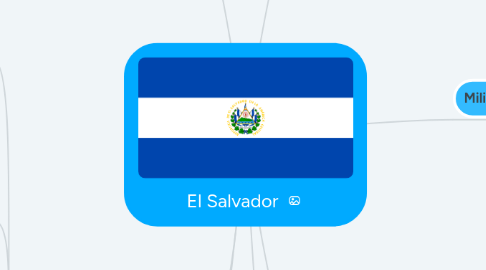
1. Geographical Factors
1.1. Geographical Characteristics
1.1.1. Marked by: Mountains, central plateau, narrow coastal belt
1.1.2. Climate Zone: Tropical, temperate in uplands
1.1.3. Location: Central America, bordering North Pacific Ocean
1.1.4. Capabilities
1.1.4.1. Types of forces: The Salvadoran Army, Air Force of El Salvador, Navy of El Salvador
1.1.5. % Arable Land: 33.1%
1.2. State Borders
1.2.1. Relations with Neighboring Nations: Alliance for Sustainable Development, with 6 Central American neighbors
1.2.2. Territorial Disputes: Conejo Island, Tiger Island, Gulf of Fonseca
1.2.3. Geographical Border Features: Mountains
1.3. Infrastructure
1.3.1. 6,232 miles of roads, less than 1,242 miles are paved
1.3.2. Most infrastructure is affected by earthquakes, war, and neglect
1.4. Natural Resources
1.4.1. Primary National Resources: hydropower, petroleum, arable land, geothermal power
1.5. Environmental Threats/Natural Disasters
1.5.1. Volcanism, destructive earthquakes and volcanic activity, hurricanes
1.5.2. History of Disasters: 1917- San Salvador eruption. 1998- Hurricane Mitch. 2001- earthquakes. 2002- San Miguel eruption.
1.5.3. Past Disasters and Stability: disasters increased emigration to the U.S.
1.5.4. Drought
1.5.4.1. Susceptible to drought and desertification
1.5.4.2. Long Term: 2014 record drought, affected 96,000 Salvadoran families
1.6. Water
1.6.1. Water Access: Rio Lempa River, North Pacific Ocean, Gulf of Fonseca
1.6.2. Major Port: Puerto Cutuco
1.6.3. Rainfall: 68 inches/year
1.6.4. Water Quality: 90% of surface water is contaminated and deemed unsafe to drink
2. Biographical Factors
2.1. Population: 6,187,271
2.2. Official Language: Spanish
2.3. Religion: 50% Roman Catholic, 36% Protestant, 2% other, 12% none
2.4. Life Expectancy: 73.51 years
2.5. Ancestry: Native American and European Spanish
3. Social Factors
3.1. Education
3.1.1. Accessibility: Only 50% have access, 300,000 youth are not in school or work
3.1.2. Funding: 3.45% of GDP
3.2. Culture
3.2.1. Ethnicities: Mestizo, Caucasian, Amerindian, African American, other
3.2.2. Languages: Spanish, Nawat
3.2.3. Traditions: "Holy Week", August festival
3.2.4. Freedom of Press: Yes, protected by the constitution
3.2.5. Freedom of Assembly: Upheld but not guaranteed
3.3. Healthcare
3.3.1. 27 basic healthcare systems
3.3.2. Access: 1/3 lack access
3.3.3. State-run healthcare
3.4. Population Demographics
3.4.1. Mortality Rates: 54 deaths out of every 100,000 people
3.4.1.1. Primary Cause of Death: Coronary heart disease
3.4.2. Literacy Rates: Male- 90%, Female- 86.2%
3.4.3. Mass Movement
3.4.3.1. Immigration: 1.1 million (20%) Salvadoran immigrants
3.4.3.2. Refugees: 10.55 million
3.4.4. Health: Doctor-patient ratio is low, doctors only serve in urban areas, malnutrition
3.4.5. Labor Participation Rates: 61.90%
3.4.6. Median Age: 25.8 years
3.4.7. Poverty rates: 35% very poor, 30% poor
3.4.8. Top Crimes Committed: homicide, extortion
4. Economic Factors
4.1. Economic Measures
4.1.1. GDP: $24.81 billion
4.1.2. GNP: $48.08 billion PPP dollars
4.1.3. National Debt: $15.51 billion
4.1.4. Balance of Trade: -$536.6 million
4.1.5. Unemployment Rate: 7%
4.1.5.1. Currency Exchange Rate: 1USD=0.89 Euro
4.1.6. Inflation Rate: 1%
4.2. Imports/Exports
4.2.1. Import Partners: China, Guatemala, Honduras, Mexico, US
4.2.1.1. Commodities: raw materials, fuels, petroleum, electricity
4.2.2. Export Partners: Costa Rica, Guatemala, Honduras, Nicaragua, US
4.2.2.1. Commodities: coffee, sugar, textiles & apparel, ethanol, iron & steel manufacturers
4.2.3. Exports/Imports Ratio
4.2.3.1. Exports: 27.6%
4.2.3.2. Imports: -44.9%
4.3. Economic Policies
4.3.1. Free Trade Agreements: 2006 Dominican Republic-Central American Agreement
4.4. Type of System
4.4.1. Mixed economy system
4.5. Weak or Strong Economy?
4.5.1. Weak, subject to political influence
5. Military
5.1. Finance
5.1.1. % of GDP: .87%
5.1.2. Defense Budget: $245 million (2017)
5.1.3. Foreign Investment: $792 million (2017)
5.2. Organizational Structure
5.2.1. 6 military zones each with their own infantry brigade
5.3. Current Operations
5.3.1. Relationships with Foreign Forces: member of the United Nations
5.3.2. Training Operations: international military education & training program in the U.S.
5.4. Status
5.4.1. Ranked 131/136
6. Political Factors
6.1. Elections
6.1.1. Election Type: Absolute majority
6.1.2. Intimidation: Gang violence during elections
6.2. Government Structures
6.2.1. Government Type: Presidential Republic
6.2.2. Key Officials: President Salvador Sanchez Ceren, Vice President Salvador Oscar Ortiz
6.2.3. Foreign Relations: Member of the United Nations & its specialized agencies
6.2.4. Factions: Multi-party system. Nationalist Republican Alliance and the Farabundo Marti National Liberation Front
6.2.5. Decentralized
6.2.6. Constitution: 1983 Constitution of El Salvador
6.2.7. Citizen Input: Citizen Participation and Governance project
6.3. Judiciary
6.3.1. Supreme Court, consists of 15 judges
6.4. Corruption Rates
6.4.1. 112 out of 180
6.5. Leader
6.5.1. Health
6.5.1.1. Physical: 74 years old, faces unspecified health challenges, treated in Cuba
6.5.1.2. Psychological: Poorly governs and leads
6.6. Internal and External Opposition to the Government
6.6.1. Terror Attacks:n1985 Zona Rosa attack
6.6.2. Coups: Salvadoran Civil War (1980-92)
7. Technological Factors
7.1. Telecommunications
7.1.1. Cell Phone Use: 9,982,186 users
7.1.2. Telephone Landlines: 677,599 users
7.1.3. Satellites: Earth station- 1 intelstat
7.2. Statewide Access to Modern Technologies:
7.2.1. Access to Internet: 29%
7.2.2. Automobile Use: 49/1000 people
7.2.3. Access to Electricity: 83.4%
7.2.3.1. Geothermal energy is privately owned, hydroelectric generation is publicly owned
7.3. Military
7.3.1. 6 Infantry Brigades, 1 Artillery Brigade, 7 Military Detachments, and 1 Engineer Detachment
7.4. Nanotechnology
7.4.1. Early stages
7.4.2. Setting up nanotechnology education
7.4.3. 1st national congress on nanoscience was on November 15, 2018

